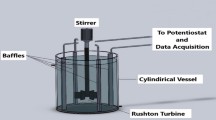Abstract
In water treatment processes, the individual unit operations are complex, highly non-linear and poorly understood. Whilst many models have been developed to improve process understanding, these are rarely in a form easily exploited by the control engineer. Attempts to improve the performance of water treatment works through the application of improved control and measurement have had variable success. This paper discusses investigations into the application of feedback control on the clarification process of a large-scale pilot plant using a streaming current detector (SCD). The application is aimed towards maximising the efficiency of the chemical coagulation process. To achieve this, a simple model of the interactions of process operating conditions on the SCD measurements must be made.












Similar content being viewed by others
References
Bernazeau F, Pieronne P, Duguet JP (1992) Interest in using streaming current detector for automatic coagulant dose control - organics removal and safety. Water Supply 10(4):87–96
Bishop S (1992) Use of the streaming current detector at Langsett Water Treatment Works. J Inst Water Environ Manag 6(1):1–9
Critchley RF, Smith EO, Pettit P (1990) Automatic coagulation control at water-treatment plants in the north-west region of England. J Inst Water Environ Manag 4(6):535–543
Dentel SK, Thomas AV, Kingery KM (1989) Evaluation of the streaming current detector. I. Use in jar tests. Water Res 23(4):413–421
Lind C (1994) Coagulation control and optimization: part one. Public Works 125(11):56–57
Nahm ES et al (1996) Development of an optimum control software package for coagulant dosing process in water purification system. Proceedings of SICE Annual Conference, Tottori, Japan, 24–26 July, pp 1157–1161
Cox CS, Graham J (1994) Steps towards automatic clarification control. IEE Colloq. advances in control in the process industries: an exercise in technology transfer, Computing and Control Division, London, UK, 30th March 081, pp 6/1–6/4
Ellis GW et al (1991) Chemical dosing of small water utilities using regression analysis. J Environ Eng 117(3):308–319
Han TH et al (1997) Optimization of coagulant dosing process in water purification system. Proceedings of SICE annual conference, Tokushima, Japan, July 29–31, pp 1105–1109
Acknowledgements
This work was supported through the PRAME funding of the Lyonnaise des Eaux Group. The authors are also grateful for the technical support and co–operation of the staff of Northumbrian Water Ltd.
Author information
Authors and Affiliations
Corresponding author
Rights and permissions
About this article
Cite this article
Adgar, A., Cox, C.S. & Jones, C.A. Enhancement of coagulation control using the streaming current detector. Bioprocess Biosyst Eng 27, 349–357 (2005). https://doi.org/10.1007/s00449-005-0413-5
Received:
Accepted:
Published:
Issue Date:
DOI: https://doi.org/10.1007/s00449-005-0413-5




